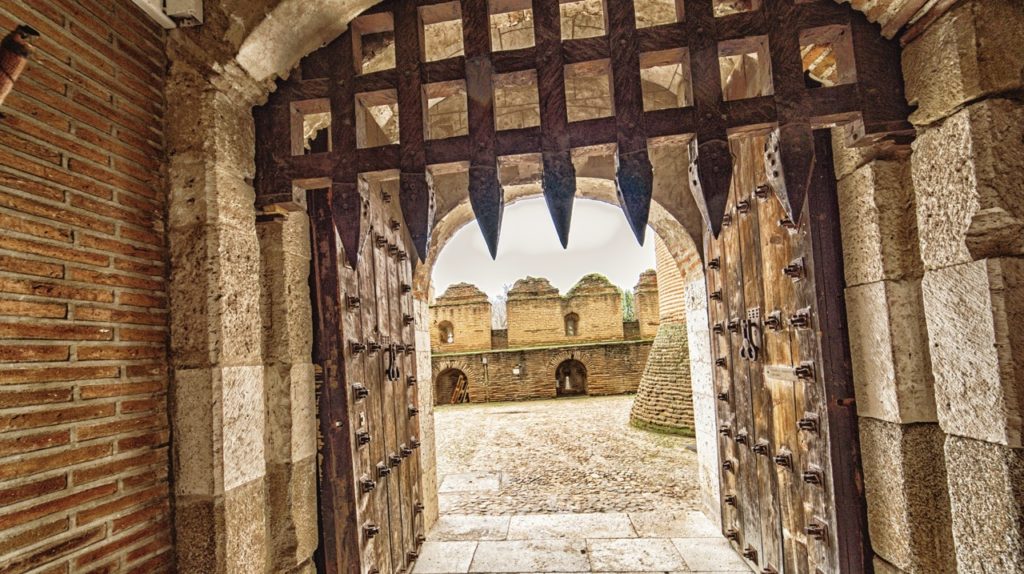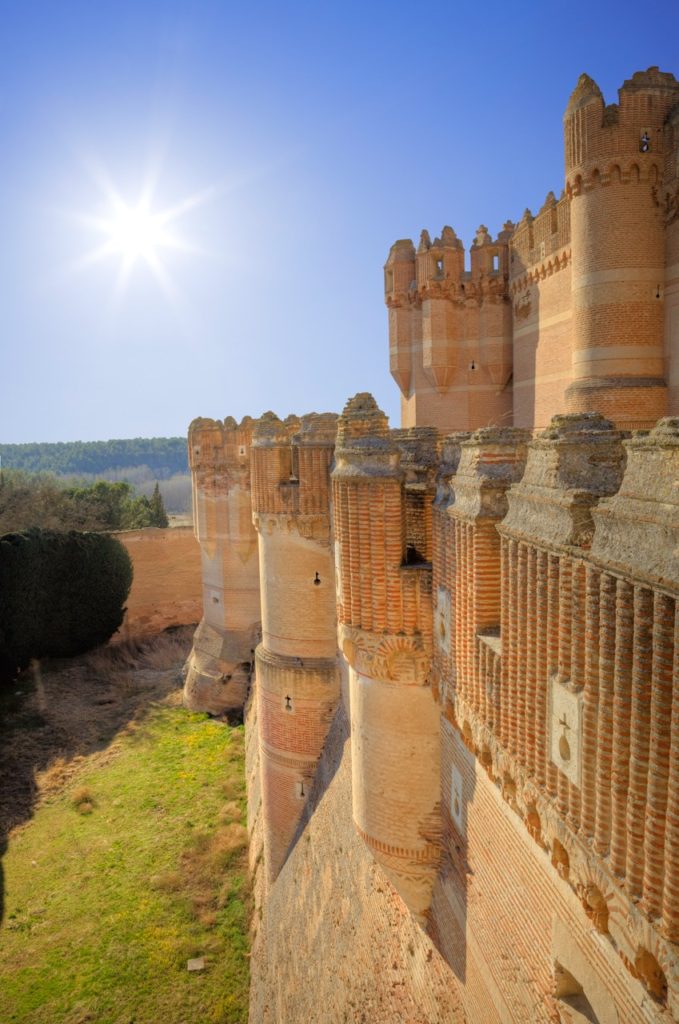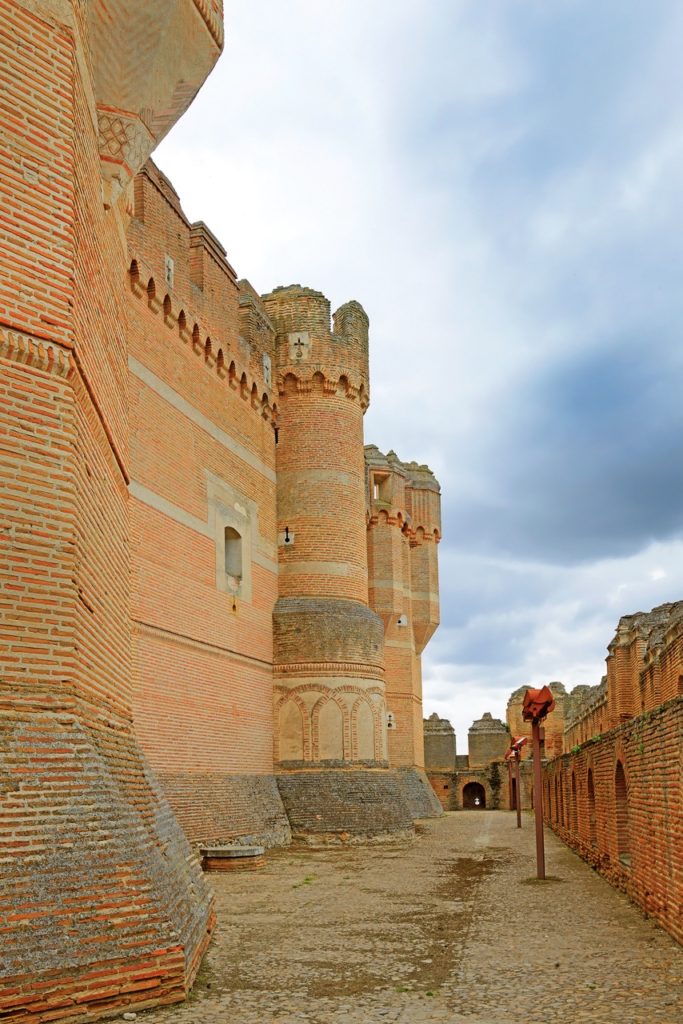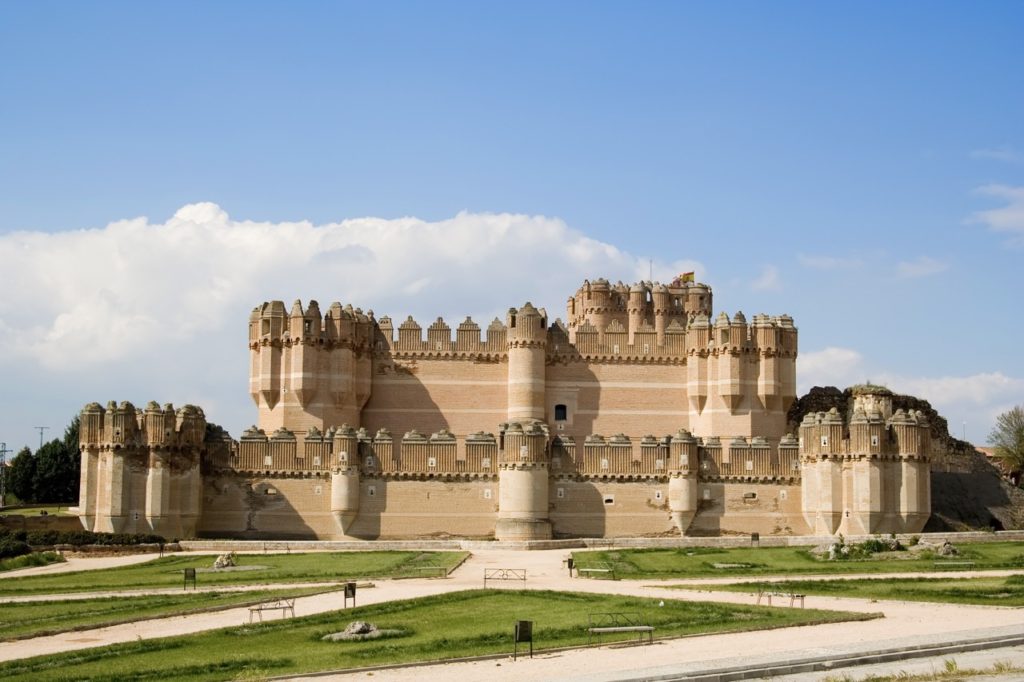Marvelous Masonry: Castillo de Coca
Words: Cass SternNestled in the heart of Spain, standing amidst the Castilian landscape, lies the formidable Castillo de Coca, a testament to the grandeur of Spanish medieval architecture. This majestic fortress, with its intricate masonry work, not only narrates the region's history but also showcases the ingenuity of ancient craftsmen. In this article, we embark on a journey to explore the history, techniques, materials, and conservation efforts revolving around the remarkable masonry of Castillo de Coca.
The history of Castillo de Coca is a tapestry woven with threads of power, ambition, and resilience. Its story begins in the 15th century amidsåt the political turbulence of medieval Spain. Commissioned by Alonso de Fonseca, Archbishop of Seville, the fortress was envisioned as a bastion of strength, a symbol of authority in a landscape fraught with conflict.
Construction of Castillo de Coca commenced in 1453 under the guidance of Alonso de Covarrubias, a master architect renowned for his visionary designs. Drawing inspiration from Moorish and Christian architectural traditions, Covarrubias conceived a structure that transcended mere fortification, embodying the ideals of beauty and functionality.
As the walls of Castillo de Coca were constructed, they witnessed the shifting tides of power that swept across the Iberian Peninsula. The fortress was completed in 1473 and served multiple purposes over the centuries, including as a military stronghold, a noble residence, and even a state prison during the Spanish Civil War. From the Reconquista, which saw Christian forces reclaiming territory from Moorish rule, to the consolidation of Spain under the Catholic Monarchs, the Castillo stood as a silent sentinel, its silhouette a reminder of the unbreakable spirit of its creators.

Castillo de Coca would become the center of intrigue and ambition in the following centuries. Its strategic location, nestled amidst fertile lands and surrounded by rivers, made it an ideal defensive structure during conflict. As noble families fought for control of Castile, the fortress changed hands numerous times, leaving each new lord's mark upon its walls. From lavish banquets to clandestine meetings of state, Castillo de Coca bore witness to the pageantry and politics of the Spanish Renaissance.
However, perhaps the darkest chapter in the fortress's history came during the Spanish Civil War when it served as a state prison for political dissidents. The walls that once echoed with the laughter of nobles reverberated with the cries of the oppressed, a stark reminder of the human cost of power and ambition.
Despite the passage of time and the trials of history, Castillo de Coca endures as a symbol of resilience and endurance today. Its walls, weathered by centuries of wind and rain, still stand tall as evidence of the skill and craftsmanship of its creators. Today, as visitors worldwide flock to marvel at its beauty, Castillo de Coca continues to inspire awe and admiration, a living testament to the enduring legacy of Spain's medieval past. Its architectural significance continues to garner attention from military strategists, historians, and architects alike.
The masonry of Castillo de Coca epitomizes the skill and craftsmanship of medieval artisans, and its construction demonstrates the mastery of masonry techniques prevalent during the Spanish Renaissance. The fortress's walls, adorned with intricate patterns and symmetrical designs, reflect the skill and precision of the craftsmen who worked tirelessly to bring Alonso de Covarrubias' vision to life.
The most notable feature of Castillo de Coca's masonry is its exquisite blend of architectural styles. While predominantly Gothic in design, elements of Mudéjar and Renaissance styles can also be observed, reflecting the cultural influences prevalent during its construction.
The materials used in the construction of Castillo de Coca are as diverse as they are durable. Local limestone, known for its strength and availability, forms the backbone of the fortress. Additionally, bricks, timber, and even mud mortar were utilized in various sections, each chosen for its specific properties and suitability to the task at hand.
At the heart of Castillo de Coca's masonry lies the technique known as ashlar construction. Derived from the Latin word "axilla," meaning "a small stone," ashlar masonry uses precisely cut and shaped stones, known as ashlars, laid in a uniform pattern to create a seamless facade. This meticulous approach not only enhances the structural integrity of the fortress but also lends it a sense of architectural grandeur with the symmetry and grandeur of the edifice.
The process of ashlar masonry begins with selecting suitable stones from local quarries. These stones, typically limestone or sandstone, are chosen for their durability and uniformity of texture. Once selected, the stones are transported to the construction site, where skilled stonemasons meticulously shape them using hand tools and mechanical implements.


Shaping the stones is a laborious process that requires precision and attention to detail. Using chisels, hammers, and saws, the stonemasons carefully carve each stone to the desired dimensions, ensuring they fit snugly together without gaps or irregularities. This detailed work is essential to achieving the uniformity and symmetry characteristic of ashlar masonry.
Once the stones have been shaped, they are laid in place using a combination of mortar and mechanical fasteners. The mortar, typically composed of lime, sand, and water, acts as a bonding agent, holding the stones together and providing additional strength and stability to the structure. In some cases, craftsmen may also use metal dowels or clamps to secure the stones, particularly in areas subject to high winds or seismic activity.
The final step in ashlar masonry is the finishing touches. Skilled craftsmen use various techniques to enhance the fortress's aesthetic appeal, including carving decorative motifs, sculpting ornate cornices, and adding embellishments like finials and gargoyles. These details beautify the structure and imbue it with grandeur and majesty, characteristic of its noble purpose.
As with any historical monument, preserving Castillo de Coca's integrity is paramount. Over the years, various conservation efforts have been undertaken to ensure this architectural gem continues to stand the test of time. The preservation of Castillo de Coca is a labor of love undertaken by dedicated professionals and passionate enthusiasts alike. As the fortress stands as a symbol of Spain's rich cultural heritage, ensuring its longevity requires meticulous planning, careful execution, and a deep understanding of historical preservation techniques and modern conservation practices.
One of the most significant conservation efforts surrounding Castillo de Coca is the ongoing restoration work to safeguard its structural integrity. Led by teams of skilled craftsmen, architects, and conservationists, these endeavors involve a comprehensive assessment of the fortress's condition, followed by targeted interventions to address areas of deterioration and instability. Using traditional techniques and authentic materials, these experts meticulously repair and reinforce the masonry, safeguarding it against the ravages of weather and time.
Central to the restoration process is the principle of minimum intervention, which seeks to preserve as much of the fortress's original fabric as possible. This approach involves careful documentation of the existing masonry, including detailed surveys and photographic records, to inform decision-making and ensure that any interventions are sensitive to the site's historical significance.
Restoration efforts often focus on repairing or replacing damaged stonework using traditional materials and techniques. Skilled stonemasons painstakingly carve new stones to match the originals' size, shape, and texture, ensuring seamless integration with the existing masonry. Similarly, historic mortar recipes are employed to recreate the traditional lime-based mortars used in the construction of the fortress, ensuring compatibility and longevity.

In addition to physical conservation work, educational initiatives are crucial in raising awareness about the importance of preserving Castillo de Coca and other cultural heritage sites. Guided tours, lectures, and workshops provide opportunities for visitors to learn about the fortress's history, architecture, and conservation, fostering a deeper appreciation for its significance and instilling a sense of stewardship among the public. These initiatives aim to instill a collective responsibility toward preserving cultural heritage by engaging the public and fostering a sense of ownership.
For example, a local corporation sponsors educational programs and workshops at Castillo de Coca to engage schoolchildren and community members in heritage conservation. Funding from the corporate sponsor supports the development of educational materials, the hiring of qualified instructors, and the provision of transportation for school groups. These programs raise awareness about preserving cultural heritage and inspire future generations to become stewards of Castillo de Coca and other historic sites.
Furthermore, collaborations with academic institutions, government agencies, and nonprofit organizations enable the implementation of innovative conservation techniques and the exchange of knowledge and expertise. Research projects, training programs, and public-private partnerships contribute to developing best practices in heritage conservation and ensure that Castillo de Coca remains a beacon of cultural heritage for generations to come.
Partnerships with universities and research institutions bring archaeology, architecture, materials science, and conservation experts together. These collaborations facilitate in-depth studies of Castillo de Coca, including architectural analysis, material characterization, and historical research. Through research projects funded by academic grants, scholars explore new methods for preserving the fortress's masonry, such as non-invasive imaging techniques to assess structural integrity or experimental testing of traditional building materials.
Collaborative research projects combine multidisciplinary teams to investigate specific aspects of Castillo de Coca's conservation. These projects may focus on the deterioration mechanisms affecting the fortress, developing conservation treatments for fragile masonry, or documenting historical building techniques. By sharing data, methodologies, and findings, researchers contribute to the collective knowledge of heritage conservation and inform evidence-based conservation practices.
For example, researchers from a local university's Department of Materials Science have collaborated with conservationists to study the limestone composition and deterioration mechanisms used in Castillo de Coca's masonry. Through laboratory analysis and field investigations, they identify specific factors contributing to the degradation of the fortress's stonework, such as environmental exposure, biological growth, and salt crystallization. This research informs the development of targeted conservation strategies, such as applying protective coatings or using consolidants to reinforce deteriorated stone surfaces.
Castillo de Coca has also joined an international research consortium that conserves historic fortifications. Scholars, conservationists, and archaeologists from various countries collaborate on interdisciplinary research projects, sharing expertise and resources to address common challenges in heritage conservation. The consortium conducts comparative studies of masonry conservation techniques, exchanges best practices, and develops innovative approaches to sustainable preservation.
Local, regional, and national government agencies also play a crucial role in heritage conservation by providing funding, regulatory oversight, and technical expertise. Collaborating with agencies such as the Spanish Ministry of Culture, regional heritage boards, and local municipalities ensures conservation efforts comply with legal requirements and adhere to established standards. Government support also enables the implementation of large-scale restoration projects, infrastructure improvements, and public outreach initiatives to promote awareness and appreciation of Castillo de Coca's cultural significance.

For example, the regional heritage board allocates funding for a comprehensive restoration project to conserve Castillo de Coca's masonry and improve visitor facilities. Skilled craftsmen, contracted through a competitive bidding process, carry out the restoration work under the supervision of heritage conservation experts. The project includes repairing damaged stonework, consolidating unstable structures, and installing new interpretive signage to enhance visitors' understanding of the fortress's history and architecture.
Nonprofit organizations dedicated to heritage conservation also serve as valuable partners in preserving Castillo de Coca. These organizations, such as heritage trusts, preservation societies, and advocacy groups, provide financial support, volunteer manpower, and advocacy efforts to supplement government resources. Through fundraising campaigns, volunteer workdays, and public awareness campaigns, nonprofits mobilize community support and engage stakeholders in conservation. Additionally, partnerships with international heritage organizations facilitate knowledge exchange, technical assistance, and collaborative projects that leverage global expertise to address conservation challenges.
For example, a local heritage preservation society organizes volunteer workdays at Castillo de Coca, inviting community members to participate in hands-on conservation activities. Volunteers receive training from conservation professionals on techniques such as repointing mortar joints, cleaning stone surfaces, and documenting architectural features. These volunteer efforts supplement ongoing conservation work and foster a sense of community ownership and pride in preserving Castillo de Coca's cultural heritage.
Training programs and workshops provide capacity-building and professional development opportunities within the conservation field. These initiatives offer hands-on training in traditional craftsmanship, conservation techniques, and heritage management practices. By equipping conservation professionals, artisans, and volunteers with the skills and knowledge needed to care for Castillo de Coca, training programs ensure the continuity of conservation efforts and foster a culture of stewardship among future generations.
Collaborations between public and private entities harness the strengths of both sectors to achieve shared conservation goals. Private sector involvement may include corporate sponsorships, philanthropic donations, or in-kind contributions of goods and services. Public-private partnerships leverage resources, expertise, and networks to implement conservation projects efficiently and sustainably. These partnerships also promote community engagement and foster a sense of ownership among stakeholders, empowering local communities to preserve Castillo de Coca's cultural heritage actively.
For example, a public-private partnership has been formed to finance infrastructure improvements at Castillo de Coca, such as installing climate control systems and implementing sustainable energy solutions. The partnership combines government funding with private investment from corporate sponsors and philanthropic donors to fund the project. By upgrading the fortress's infrastructure, the partnership enhances its resilience to environmental threats and improves the visitor experience while minimizing the impact on the site's historic fabric.
In conclusion, the masonry of Castillo de Coca stands as a testament to the ingenuity and creativity of the human spirit. From its storied past to its enduring legacy, this fortress continues to captivate the imagination of all who behold it. In marveling at its intricate craftsmanship and timeless beauty, it is crucial to pledge to cherish and protect this architectural marvel for future generations. Preserving Castillo de Coca is honoring the past and the shared heritage as custodians of history.